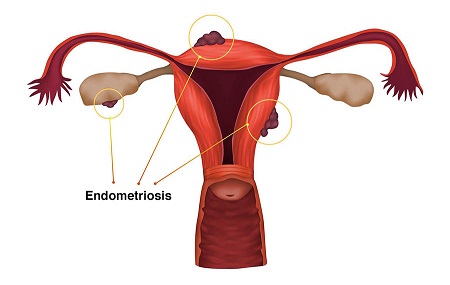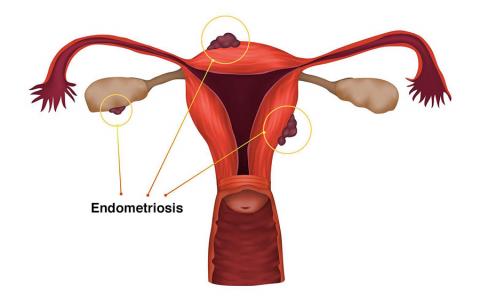What is endometriosis?
 Endometriosis is a disorder in which endometrial tissue (similar to the tissue that lines the uterus) grows outside the uterus in places where it doesn't belong.
Endometriosis is a disorder in which endometrial tissue (similar to the tissue that lines the uterus) grows outside the uterus in places where it doesn't belong.
With endometriosis, deposits of tissue that act just like the tissue lining the uterus develop outside the uterus. This tissue thickens, breaks down, and bleeds with each period. But the blood has no way to leave the body and becomes trapped. This can cause pain during ovulation, menstruation, intercourse and even while having a bowel movement or urinating. This tissue is ‘sticky’ once outside the uterus and can lead to inflammation and scarring, most commonly described as adhesions.
Unfortunately, endometriosis is hard to diagnose. Due to this, it can take, on average, 6.5 – 8 years for a definitive diagnosis.
Recent research suggests that endometriosis may have a genetic component, may be due to metaplasia (where normal pelvic tissue turns into endometrial tissue) or retrograde menstruation. Retrograde menstruation is where the menstrual blood is pushed up through the fallopian tubes rather than out via the cervix. In some cases, the body clears this away and nothing happens. Unfortunately, for endometriosis sufferers, this is the tissue that can cause inflammation and adhesions due to not being cleared away.
How is endometriosis different from dysmenorrhoea (period pain)?
Dysmenorrhoea is sometimes a symptom of endometriosis. Not all who have been diagnosed with endometriosis experience dysmenorrhoea.
Primary dysmenorrhoea (PD) can be defined as back pain and/or abdominal pain associated with the menstrual cycle in the absence of an underlying medical condition (such as endometriosis or polycystic ovarian syndrome).
Up to 50% of women of childbearing age are affected by PD. 10% of sufferers are affected so badly that for the first few days of their period, they are unable to perform their usual daily tasks.
Unfortunately, as a society we have started to normalise PD. This then flows on to make it hard for those experiencing PD to be investigated for any underlying condition.
How can Osteopathy help?
During any Osteopathic consultation, the whole body is assessed for regions of dysfunction. Endometriosis and PD can affect the neck (through nerve connections), through the back to the pelvis and the ligaments that connect the reproductive organs to the back and pelvis.
Osteopaths treat the musculoskeletal findings and then, working through the organs with visceral Osteopathic techniques*, treatment can loosen tight tissues, improve range of motion and has been shown to decrease the symptoms experienced.
*It should be noted that not all osteopaths use Visceral techniques as this requires further training.

